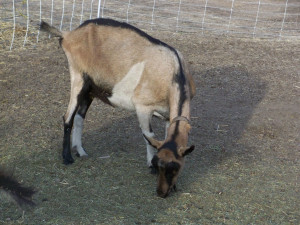Wanting a smaller dairy animal, we turned our attention to goats and settled on the lovely Alpine breed. We thoroughly enjoy their friendly dispositions! And the delicious raw milk is used to make nutritious cultured products like kefir, cheese, and buttermilk.
The basic diet of our goats is hay, pasture, and forage/browse. Far from being typical “grain-fed” goats, our does’ milk time ration includes non-GMO soy & corn-free fermented grains. Fermented grains do not disturb rumen activity but actually improve gut health, digestibility, milk production, and weight retention which can be tricky with dairy breeds. They also receive DE, organic kelp, and SEA-90 Animal Essentials mineral salts. If called for, an herbal dewormer is used. Read about our home dairy setup.
The elegant Alpine has its roots in the French Alps; yes, that famous European mountain range. Still, the most popular breed in France and widespread there, these goats are also known as French Alpines. Selection through the years focused on size and production instead of a common color or pattern thus this breed has an array of beautiful colors and patterns, with descriptive French names no less!
Given their lovely array of colors, long production of high-quality milk, and friendly dispositions, it’s no wonder the Alpine goat is the second most popular breed in the U.S.!
Early voyagers brought these goats along with them for milk and meat, releasing some of the animals on islands along their routes. Alpines first appeared in North America in the early 1900s when the first documented herd, consisting of 18 does and 3 bucks, was imported from France.
Alpines are a medium to large-sized goat breed. They have the ability to adapt to any climate due to their hardy nature (imagine life in the Alps!), are sturdily built making terrific pack goats, and are less vocal than some breeds. Friendly and highly curious, they are a docile goat that makes for great pets, show animals, and brush-eaters; trained wethers are a top choice as sturdy pack goats. Some folks note that Alpines are more independent than other breeds, generally at the top of herd hierarchy, and occasionally willful. This combination of traits makes Alpine goats especially enjoyable!
The adult doe should stand no less than 30 inches at the withers and weigh no less than 135 pounds; adult Bucks, no less than 34 inches and 170 pounds. The breed has short to medium-length hair, upright ears, and a straight facial profile that gives it a graceful, alert expression. Bucks often have long hair along the spine and a pronounced masculine beard, but Does can also have a small beard. Alpines reach sexual maturity early. Twins are most common, on up to quintuplets, although they can have singles.
Traditional Alpine colors are described using the following French terms:
- Cou Blanc (coo blanc) – which means “white neck” – white front quarters and black hindquarters with black or gray markings on the head.
- Cou Clair (coo clair) – literally “clear neck” – front quarters are tan, saffron, off-white, or shading to gray with black hindquarters.
- Cou Noir (coo nwah) – meaning “black neck” – Black front quarters and white hindquarters.
- Sundgau (sundgo) – Black with white markings such as the underbody, facial stripes, etc.
- Pied – spotted or mottled.
- Chamoisée (shamwahzay) – brown or bay – characteristic markings are black face, dorsal stripe, feet and legs, and sometimes a martingale running over the withers and down to the chest. Spelling for male is Chamoise (shamwahz).
- Two-tone Chamoisée – light front quarters with brown or grey hindquarters. This is not a Cou Blanc or Cou Clair as these terms are reserved for animals with black hindquarters.
- Broken Chamoisée – a solid Chamoisée broken with another color by being banded or splashed, etc.
- Any variation in the above patterns broken with white should be described as a broken pattern such as a Broken Cou Blanc.
Alpines excel as dairy animals in both commercial operations and the homestead, producing a high volume of milk over a long lactation period, with the ability to be milked through without rebreeding. Their milk has a good protein and butterfat content, lending itself well to cheese production as well as ice cream, other dairy products, and soap making. Alpine milk has a relatively low-fat content, with an average butterfat of 3.4%. It is higher in sugars than cows’ milk but balances itself in the amount of protein. Alpine goats’ milk has 2.3g of protein per 250ml while cow’s milk has 3.4g. A higher protein count is not always good since it means more calories with increased fat content. Compared to Saanen goat milk, Alpine is higher in all nutritional aspects, except the fat content.
Given their lovely array of colors, long production of high-quality milk, and friendly dispositions, it’s no wonder the Alpine goat is the second most popular breed in the U.S.!
Alpine Goat Traits-at-a-Glance
Adaptable to any climate
Excellent foragers
Intelligent, friendly, docile, independent
Prolific- twins most common, up to quintuplets
High milk volume excellent for cheese production
Long lactation
Wide range of colors
More information


